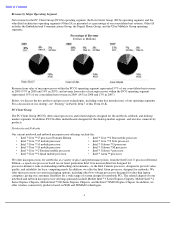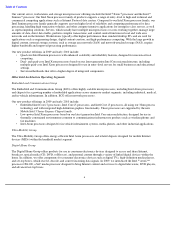Intel 2009 Annual Report Download - page 16
Download and view the complete annual report
Please find page 16 of the 2009 Intel annual report below. You can navigate through the pages in the report by either clicking on the pages listed below, or by using the keyword search tool below to find specific information within the annual report.
Table of Contents
We believe that our network of manufacturing facilities and assembly and test facilities gives us a competitive advantage. This
network enables us to have more direct control over our processes, quality control, product cost, volume, timing of production,
and other factors. These facilities require significant up-front capital spending and therefore make it difficult for us to reduce
our costs in the short-
term. Many of our competitors do not own such facilities because they may not be able to afford to do so
or because their business models involve the use of third-party foundries and assembly and test subcontractors for
manufacturing and assembly and test. The third-
party foundries and subcontractors may also offer intellectual property, design
services, and other goods and services to our competitors. These “fabless semiconductor companies” include Broadcom
Corporation, NVIDIA Corporation, QUALCOMM Incorporated, and VIA Technologies, Inc. (VIA). Some of our competitors
own portions of such facilities through investment or joint-venture arrangements with other companies.
We plan to continue to cultivate new businesses and work with the computing and communications industries through
standards bodies, trade associations, OEMs, ODMs, and independent software and operating system vendors to help align the
industry to offer products that take advantage of the latest market trends and usage models. We frequently participate in
industry initiatives designed to discuss and agree upon technical specifications and other aspects of technologies that could be
adopted as standards by standards-setting organizations. Our competitors may also participate in the same initiatives and
specification development. Our participation does not ensure that any standards or specifications adopted by these
organizations will be consistent with our product planning.
Microprocessors
We continue to be largely dependent on the success of our microprocessor business. Our ability to compete depends on our
ability to deliver new microprocessor products with increased performance capabilities and improved energy-efficient
performance at competitive prices. Some of our microprocessor competitors, such as Advanced Micro Devices, Inc. (AMD),
market software-compatible products that compete with our processors. We also face competition from companies offering
rival architecture designs, such as Cell Broadband Engine Architecture developed jointly by International Business Machines
Corporation (IBM), Sony Corporation, and Toshiba Corporation; Power Architecture* offered by IBM; ARM* architecture
developed by ARM Limited; and Scalable Processor Architecture (SPARC*) offered by Sun Microsystems, Inc. (a subsidiary
of Oracle Corporation). In addition, NVIDIA is seeking to position its graphics processors to compete with microprocessors,
by shifting some of a microprocessor’s workload to its graphics processor.
While AMD has been our primary competitor in the market segments for microprocessors used in notebooks, desktops, and
servers, QUALCOMM and other companies using ARM-based designs are our primary competitors in the growing market
segment for microprocessors used in handhelds, including smartphones and MIDs. Our ability to compete with QUALCOMM
and other competitors in this market segment depends on our ability to design and produce high-performance, energy-efficient
microprocessors at competitive prices. It also requires us to develop a software ecosystem that appeals to end users and
software developers. We have taken a number of steps to build this software ecosystem, including developing the Moblin
TM
-
based operating system and subsequently combining it with Nokia Corporation’s Maemo* software platform to create
MeeGo*, a Linux-based software platform that will run on multiple hardware platforms; acquiring Wind River Systems, Inc.;
and creating the Intel
®
Atom
TM
Developer Program. In addition, in 2009 we entered into product development collaborations
with LG Electronics, Inc. and Nokia.
The following is a list of our main microprocessor competitors by market segment:
Chipsets
Our chipsets compete with chipsets produced by companies such as AMD (including chipsets marketed under the ATI
Technologies, Inc. brand), Broadcom, NVIDIA, Silicon Integrated Systems Corporation, and VIA. We also compete with
companies offering graphics components and other special-purpose products used in the notebook, netbook, desktop, and
server market segments. One aspect of our business model is to incorporate improved performance and advanced properties
into our microprocessors and chipsets, for which demand may increasingly be affected by competition from companies whose
business models are based on dedicated chipsets and other components, such as graphics controllers.
11
•
Notebook: AMD and VIA
•
Netbook: AMD, NVIDIA, QUALCOMM, and VIA
•
Desktop: AMD and VIA
•
Server/Workstation: AMD, IBM, and Sun Microsystems
•
Embedded: AMD, Freescale Semiconductor, Inc., and Texas Instruments Incorporated
•
Handheld: QUALCOMM
























